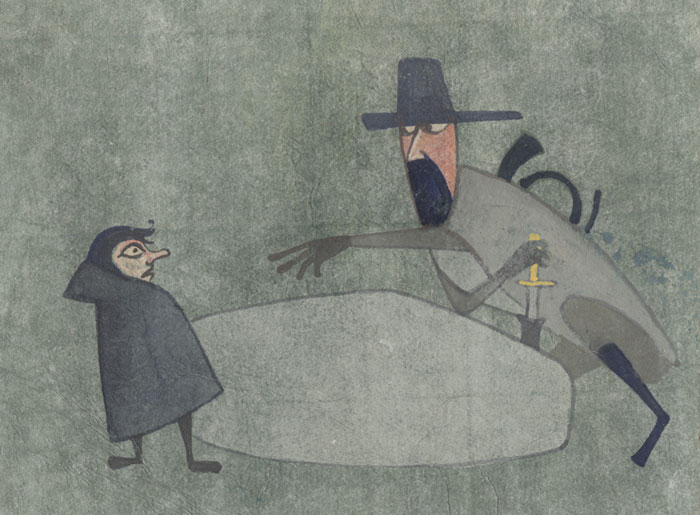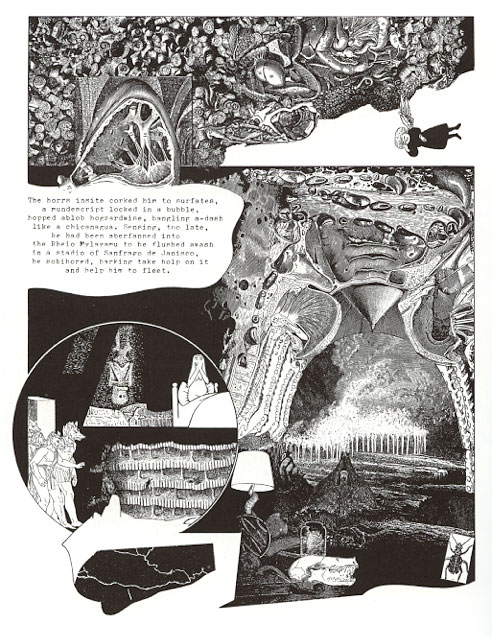'The Iron Parachute' (published in 2016).
Cor Blok was a Dutch art critic, art history professor, illustrator and, after nearly 50 years of labor, a published graphic novelist. His most famous works are his paintings and illustrations based on J.R.R. Tolkien's epic saga 'Lord of the Rings'. Some of Blok's paintings were used as covers for Dutch-language editions of the 'Ring' trilogy. Tolkien liked Blok's artwork so much, he bought two of his paintings. At 82, when his graphic novel 'The Iron Parachute' was published in 2016, Cor Blok became the oldest known Dutchman ever to debut as a comic artist.
Early life
Born in 1934, Cornelis Blok studied at the Academy of Fine Arts in The Hague, and graduated in 1956. In his professional life, he worked as an art history teacher at the Academy of Fine Arts in Rotterdam and at the University of Leiden. Between 1953 and 1958, Blok developed his own fantasy world, Barbarusia. He invented centuries of history for his fictional country, including its own art history. Many of his Barbarusia drawings drew from historical art periods: ancient Roman wall frescos, medieval miniatures and Baroque furniture were parodied, for example. In April 1960, the "Barbarusian project" was exhibited at the Gemeentemuseum ("Municipal Museum") of The Hague, with two and three dimensional artworks.
Blok was fascinated by pre-Columbian American art and ancient Chinese and Middle Eastern culture, and his artwork was influenced by works of Giorgio De Chirico, Max Ernst, Öyvind Fahlström, David Hockney, Wassily Kandinsky, Paul Klee and R.B. Kitaj. His favorite fine artist was the Flemish painter Pieter Bruegel the Elder, whom he admired for the way he presented entire crowds with a clear, simple closed outline. Comics only started to interest Blok after Roy Lichtenstein began making canvases based on comic panels in the early 1960s. In an interview, Blok named Jean-Claude Forest's 'Barbarella', George Herriman's 'Krazy Kat' and René Goscinny & Albert Uderzo's 'Astérix' as his favorites.
Throughout his career, Cor Blok's art criticism (on individual artists, art movements and theory) was published in various illustrated books. Blok compiled a catalog of Piet Mondriaan's oeuvre (1974), wrote a history of Abstract Art (1975) as well as two tomes of theory, concerning interpretation of images: the 1967 book 'Beeldspraak' ("Metaphors") and 'Beeldvertalen ("Translating Images") in 2003. He additionally translated art books from German to Dutch, including Hans Jantzen's 'Ottonian Art'.
Tolkien art by Cor Blok: "Boromir demands the Ring".
Tolkien
Cor Blok was best known for his own artwork: illustrations of the writings of J.R.R. Tolkien, a South African-born British author famous for his fantasy novels 'The Hobbit' (1937) and the 'Lord of the Rings' trilogy (1954-1955). Set in an ancient world called Middle-Earth, Tolkien tells epic adventures of the dwarf people the Hobbits, who leave the Shire to assist Gandalf the wizard. Tolkien's fantasy world took direct inspiration from myths, legends, sagas and epic tales of world culture, and his characters were influenced by familiar ancient narrative archetypes. J.R.R. Tolkien wrote and drew an immensely detailed world in these four books, complete with calligraphy, poetry, songs and geographical maps. Most of this fantasy Hobbit-world culture had no direct relevance to the main narrative, but this rich background of detail gave his readers the impression that Tolkien's stories were descriptions of a realistically depicted ancient civilization. Tolkien's books captured the imagination of countless readers worldwide. During the 1960s and 1970s, 'The Hobbit' and 'Lord of the Rings' gained a cult following among teenagers, college students and fantasy fans. In 1965-1966, Jiři Trnka and Gene Deitch adapted 'The Hobbit' into an animated short. Ralph Bakshi's animated adaptation of 'Lord of the Rings' (1978) told the first part of the trilogy, but the film did not do well at the box office, and plans for the second and third parts were scrapped. When Peter Jackson adapted the entire 'Lord of the Rings' saga into a live-action film trilogy (released in 2001, 2002 and 2003), the film's critical success and global blockbuster status made 'Lord of the Rings' and J.R.R. Tolkien household names, even among non-readers. Jackson's film adaptation of 'The Hobbit', stretched the content of Tolkien's single book into three feature length live-action films, released yearly from 2012 to 2014. Today, Tolkien's books still rank among the best-selling and most-beloved works of literature. 'The Hobbit' has been illustrated by Bart van Erkel and Livia Rusz, while a larger group of artists, including Mike Dringenberg, Heinz Edelmann, Greg & Tim Hildebrandt, Tove Jansson, Erik Kriek and Vladimir Vesovic have produced illustrations of 'Lord Of The Rings'. At least two different comic book versions of 'Lord Of The Rings,' by Spanish cartoonist Luis Bermejo and Bulgarian artist Sotir Gelev, have appeared in print. David Wenzel adapted 'The Hobbit' into a graphic novel, scripted by Chuck Dixon and Sean Deming.
Cor Blok read 'Lord Of The Rings' in the mid-1950s, long before Tolkien was a household name. Beginning in 1958, he started creating paintings inspired by Tolkien's Middle-Earth characters, making around 140 total illustrations by 1962. Blok deliberately used a minimalistic style, leaving enough room for readers to use their own imagination to fill in details. Blok's work caught the attention of Het Spectrum, the Dutch publisher of 'Lord of the Rings', who in turn put Blok in contact with Tolkien's UK publisher, George Allen & Unwin. Through them, five of Blok's "Ring" illustrations were sent to J.R.R. Tolkien. In a letter to Rayner Unwin, Tolkien wrote: "I think they are really fascinating ... I'd love to see more, in the hope that a few are as beautiful as 'The Battle of the Trumpeter'. The other four were great as paintings, but ugly as illustrations." In August 1961, Cor Blok met J.R.R. Tolkien at the novelist's home on Sanfield Road in Oxford to discuss his illustrations. The author purchased two of Blok's paintings to be framed and hung in his house: 'The Battle of Hornburg' and 'The Dead Marshes'. Blok presented Tolkien another of his paintings, 'Dunhov', as a gift.
Illustrations by Pauline Baynes were run with J. R. R. Tolkien's 'Hobbit' and 'Rings' English-language editions, but Cor Blok's paintings found their way into other Tolkien publications. After exhibitions of Blok's illustrations in 1962 and 1963, three paintings were used as covers for the 1965 Prisma publication Dutch paperback editions of 'Lord of the Rings'. Blok's paintings were also included in the compilation 'Realms of Tolkien: Images of Middle-Earth' (HarperCollins, 1996), the 1998 and 2011 official Tolkien calendars and the 2011 HarperCollins monograph 'A Tolkien Tapestry: Pictures To Accompany The Lord of the Rings', that also featured a foreword by Cor Blok.
In 1992, during the centenary anniversary of Tolkien's birth, twenty of Blok's paintings were exhibited in the Royal Library in The Hague. Simultaneously with the release of Peter Jackson 'Lord of the Rings' films in 2001, 2002 and 2003, reprints of the the original novels were released, including editions featuring Blok's illustrations. It introduced a whole new generation to the writings of Tolkien. Another exhibition with Blok's paintings occurred in the summer of 2005, during the Lustrum celebrations of Unquendor (the Dutch Tolkien Society Unquendor), featuring Cor Blok as a guest of honor. Blok's paper, 'Pictures to Accompany a Great Story' (2008) was included in 'Lembas Extra: Proceedings of the 5th Unquendor Lustrum', a collection of articles and poetry.
The first two volumes of Prisma's Dutch-lanaguage edition of the 'Lord of the Rings' trilogy, with covers by Cor Blok (1965).
The Iron Parachute
In 1967, Cor Blok began work on 'The Iron Parachute', a graphic novel that would not be published for another 49 years. In an interview with Pieter Collier on 9 March 2010, Blok reflected: "...In my contacts with other artists I could not help noticing how many of them ended up repeating themselves or varying a single theme to the point of complete exhaustion." He observed that after the student protests of May 1968, the role of art critics came under sharper criticism and scrutiny. It made him reconsider his own art: "(...) I continued to produce 'autonomous' work during the early 1970s, but also started on a new 'project': a kind of comic strip (except that it was not particularly comic - 'graphic novel' is the up-to-date designation) in black and white, combining drawings, collage and text in various manners. This enabled me to get away from the isolated picture which no longer seemed to make sufficient sense to me, while retaining the possibility of producing variations on a single theme or motif. The latter fits naturally in the context of making a book because of the required formal continuity between pages and chapters. The graphic novel format also enabled me to use language as a means of expression alongside with the visual medium."
In 1973, Blok made his graphic novel the focus his creative efforts, but at that point, completion was still over forty years away. At the beginning, Blok had no clear story in mind, but his knowledge and interest in the history of humanity's attempts to communicate through pictures soon emerged as the book's dominant theme. It took nearly half a century before the world got a chance to see Blok's finished story in print: on 16 April 2016, Toronto-based Oloris Publishing released the first edition 'The Iron Parachute'. The 346-page book features 25 dreamlike scenes in a loosely connected narrative, comprised of highly experimental black-and-white pen and ink drawings and collage. A strongly visual work, each chapter of 'The Iron Parachute' features a different layout. Some pages have no dialogue, while others have a strong interplay of text and image.
Age record
When 'The Iron Parachute' was published in 2016, 82-year-old Cor Blok was one of the oldest known comic artists to make a graphic novel debut. However, he was not the very oldest: Rao Pingru (who was born sometime in 1922) was either 90 or 91 (eight or nine years older than Cor Blok) when he published his debut graphic novel 'Our Story' (Guangxi Normal University Press Group, 2013). Additionally, a year after 'The Iron Parachute' was published, Geneviève Gautier, a Frenchwoman 95 years of age, published her debut graphic novel, 'Les Aventures du Pingouin Alfred' (POD, 2017), eclipsing Rao's Pingo's record by over 4 years. Still, Cor Blok does hold a national record for 'The Iron Parachute' - he is the oldest known Dutchman in history to debut with a graphic novel. Other elderly debutants were German artist Klaus Voormann, who released his first graphic novel 'Revolver 50. Birth Of An Icon' (2016) at age 79, and the Dutchman Martin Ruijters, 75 during the release of his first comic, 'Toestanden in Suriname' (2011).
Final years and death
On 22 February 2019, Blok launched an Instagram account, announcing plans for a follow-up graphic novel to 'The Iron Parachute', and a large upcoming exhibition of his work in the Netherlands, slated for 2020, to coincide with 15th annual Stripdagen Haarlem comics festival. Unfortunately, the COVID-19 pandemic postponed these plans. In 2021, Cor Blok passed away at age 87. Although his new graphic novel remains unfinished, Cor Blok's website, started in 2012 and linked below, has a variety of artwork from his lifetime to entertain interested internet users. Currently, the Cor Blok exhibition is rescheduled to open along with the Stripdagen Haarlem comic festival in 2022, providing another opportunity for the world to enjoy up close the famous Tolkien imagery and "Iron Parachute" artwork of this record-breaking Dutchman.
A page from 'The Iron Parachute' (2016).







